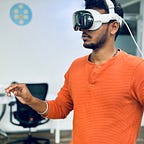How to Connect Apple Vision Pro to XCode without developer strap
In this article, we will guide you through the process of connecting your Apple Vision Pro (AVP) to XCode and running applications directly on the device without the need for a developer strap. We’ll provide a detailed, step-by-step procedure to help you deploy and test your apps on the Apple Vision Pro via WiFi. By following these instructions, you’ll be able to streamline your development workflow and make the most of your Apple Vision Pro device.
Let’s dive into the steps required to establish a seamless connection between Apple Vision Pro and XCode, and explore how to effectively run your applications on the device wirelessly.
Step 1: Ensure Network Compatibility — Make sure that both your Apple Vision Pro (AVP) and your MacBook are connected to the same WiFi network. This is crucial for establishing a successful connection between the two devices. If you are using a MacBook provided by your organization, you may need to disable any VPN or firewall settings temporarily to ensure both devices are on the same network.
Step 2: Enable Remote Device Connection on Apple Vision Pro — Goto Settings → General → Remote Devices, You will see a screen indicating that no remote devices are currently available. This is expected at this stage, as the device has not yet been paired with XCode. This steps prepare your Apple Vision Pro to be discovered and connected by XCode, setting the stage for wireless application deployment and testing.
Step 3: Configure XCode to Connect to Apple Vision Pro — To establish a connection between XCode on your MacBook and your Apple Vision Pro, follow these steps, Go to Window → Devices and Simulators → Devices. Click on the Apple Vision Pro device to add it as a remote device. This will pair the device with XCode, enabling you to deploy and test apps wirelessly.
Troubleshooting Connection Issues:
- If the Apple Vision Pro does not appear in the list of available devices, try restarting your MacBook.
- Before restarting, ensure you exit XCode to clear any cached data that might be causing the issue.
- After restarting, reopen XCode and repeat the steps to navigate to Devices and Simulators and look for the Apple Vision Pro again.
Step 4: Pair Apple Vision Pro with XCode — Once you have located your Apple Vision Pro in the Devices list within Xcode, Click the Pair button that appears in the device details section on your MacBook. This will start the pairing process between your MacBook and the Apple Vision Pro.
Step 5: Enter Pairing Code to Complete Connection — A six-digit pairing code will be displayed on the Remote Devices page. On your MacBook, within the Devices and Simulators window in XCode, a prompt will appear asking for a pairing code. Enter the six-digit code displayed on your Apple Vision Pro into the prompt in XCode. After entering the code, XCode will confirm the pairing. You should see a notification after few seconds of syncing indicating that the Apple Vision Pro is now connected and ready for use.
Step 6: Verify Successful Pairing on Apple Vision Pro — In the Remote Devices section, you should now see the name of your MacBook listed. This indicates that the pairing process was successful and your MacBook is recognized by the Apple Vision Pro.
Step 7: Enable Developer Mode on Apple Vision Pro — To ensure you can deploy and test applications on your Apple Vision Pro, Goto Settings → Privacy & Security, Within the Privacy & Security section, scroll down until you find the Developer Mode option. Toggle the switch to enable Developer Mode. A prompt may appear asking you to confirm the activation of Developer Mode. Follow the on-screen instructions to confirm. It might require to restart the device.
Step 8: Re-enable Developer Mode After Restart — Following a restart, you will be prompted again to ensure that Developer Mode is enabled. Simply click on the prompt to activate Developer Mode once more.
Step 9: Install App from XCode to Apple Vision Pro — With all the necessary settings configured and Developer Mode enabled, you are now ready to deploy your applications from XCode to your Apple Vision Pro device. Simply follow the usual process of building and running your app from XCode, and select your Apple Vision Pro as the target device for installation. This step marks the culmination of the setup process, allowing you to seamlessly transfer and test your applications on the Apple Vision Pro device.
Step 10: Handling “Untrusted Enterprise Developer” Error — Upon attempting to open the installed app on your Apple Vision Pro, you may encounter an error message stating “Untrusted Enterprise Developer.” This error typically occurs when the app’s developer certificate is not trusted by the device.
Step 11: Trust Developer Certificate in Device Management — To resolve issues with app trust on your Apple Vision Pro, Goto Setting → General → VPN & Device Management. Within the Device Management section, you will find your Apple ID listed along with developer certificates.
Find the option labeled with your team name or developer account and click on Trust next to it.
A confirmation prompt will appear, asking you to confirm your decision to trust the developer certificate. Select Trust to confirm.
After trusting the developer certificate, restart your Apple Vision Pro for the changes to take effect.
Once your device has restarted, attempt to launch the app again. This time, the app should run without any trust issues.
Read this blog to Troubleshoot: https://elanthirayan.medium.com/troubleshooting-vision-pro-and-macbook-connection-issues-29da3a1cd3b2
I hope this guide proves helpful to you. Should you have any questions or require further assistance, please feel free to leave a comment below. You can also reach out to me directly through this link for additional support. Your feedback and inquiries are always welcome!
